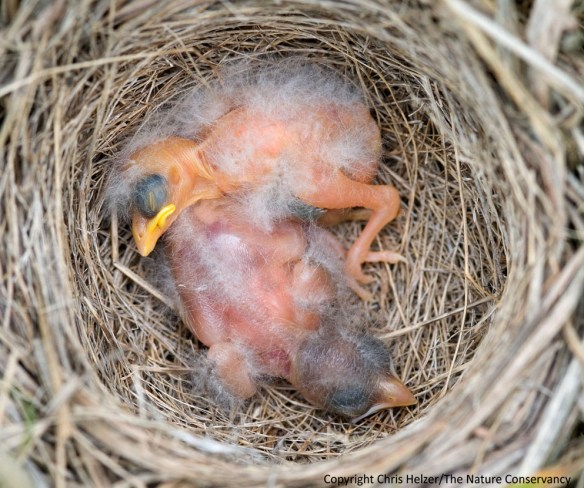Not just another pretty face…

Dickcissel chicks (just a few days old) in restored prairie - The Nature Conservancy's Platte River Prairies, Nebraska.
Birds sure are pretty. When they’re grown up! At this young age, however, they are interesting looking, but it’d be hard to argue that they’re attractive. I suppose you could say the same thing about human babies (if you could keep emotion out of it)… they’re small, skinny, hairless, and wrinkled. And yet we feed them and nurture them – and birds do the same!

Hey Chris – I just took a photo of a grasshopper sparrow nest yesterday and posted it on my FB account. It only had two eggs and I speculated on the FB caption that a clutch this late in the summer might be a second or third nesting attempt and that a two egg (i.e., small) clutch might be typical for a second or third attempt. What do you think?
I’d sure think it’s a second or third attempt – don’t know about the number of eggs part, but it sounds good to me!
I’m always amazed that birds are as successful as they are, considering how fragile hatchlings look and how open to the elements nests often are. I know some bird species just keep laying and hatching out young all summer – dickcissels must be one of those? Where do they tend to nest – small understory, shrubs?
Dickcissels usually nest 2-3 feet off the ground in a clump of grass or wildflowers by tying multiple stems together with their nest. Because they’re off the ground and open at the top, the nests are among the easiest of grassland bird nests to find.
Adult birds look very much like this under their plumage. The clothes make the bird!
Love it!
Chris-
The chicks look different, note dorsal bill color, side of gape and dorsal body color. I’d say one is a cowbird.
You’ve got good eyes! You could be right – the head color, especially, looks a little different. I certainly wouldn’t argue the point with you… This was a nest I watched through the season, and I don’t remember seeing cowbird eggs in it, but honestly don’t remember for sure.
The bigger, paler one would be the cowbird. Generally only the west coast cowbird subspecies has yellow gape parts.